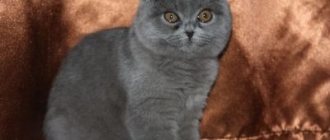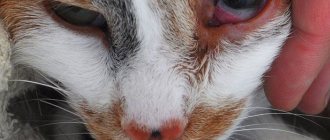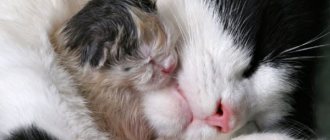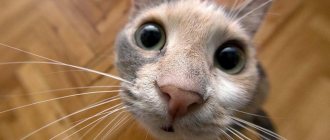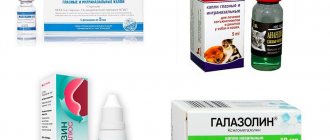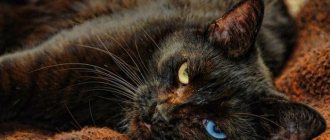A small amount of clear discharge is normal, but if a cat has brown discharge from the eyes, then this is an alarming signal that may indicate the development of some pathology. If dark discharge appears from a cat’s eyes and does not go away for several days, you should carefully observe the animal’s behavior, evaluate possible provoking factors, and seek help from a specialist.
Normal eye discharge
A cat's vision is much sharper than a human's. It helps her navigate space, hunt, quickly get acquainted with new surroundings and see in the dark.
It is normal for cats to secrete a small amount of clear fluid from their eyes. The discharge is odorless and almost colorless. Its quantity is quite scanty and has a semi-liquid consistency. It helps to cleanse the organs of vision from dust, foreign bodies (crumbs, tiny debris) and other contaminants.
In some cases, increased fluid separation is characteristic of certain breeds. For example, this is typical for Persian cats, in which the normal functioning of the nasolacrimal duct is genetically impaired.
It is also common for your pet to experience excessive tearing after sleep. The result may be an accumulation of so-called “sour marks” in the corners of the eyes, which the cat will remove on its own during hygiene procedures.
What kind of discharge is normal for cats?
A clear liquid that is barely noticeable on the fur is not a reason to worry. Animals, like humans, may experience watery eyes after waking up from sleep. If this is not the reason, the tear may have been caused by dust in the room, too bright light, smoke or some kind of chemical irritants.
This is what normal discharge from the tear ducts looks like
Important! In breeds with slightly bulging eyes, tears may flow because the cornea is drying out. If this is a Scotsman or another cat with bulging eyes, for example, a British cat, there is definitely no need to worry about a transparent drop noticed on the eye.
Causes
When a cat develops dark purulent discharge from the eyes, this indicates the development of some disease. Pathology can affect various organs and systems, and manifest itself with a similar symptom. Thus, dark discharge is a consequence of disruption of the body.
The most common causes of non-infectious discharge from the eye in a cat are:
- head or eye injuries;
- a foreign body caught on the cornea or in the lacrimal canal;
- allergy;
- pathologically narrow lumens of the lacrimal canals, which impedes the normal flow of fluid through them;
- dacryocystitis (obstruction of the lacrimal duct caused by congenital anomalies or an inflammatory process);
- congenital disorder of eyelash growth, which causes constant irritation of the cornea;
- benign and malignant neoplasms that mechanically affect the tear ducts, squeezing their lumen.
Dark and even black discharge from a cat’s eyes can occur as a result of infectious diseases:
- conjunctivitis;
- keratoconjunctivitis;
- blepharitis (inflammation of the eyelids);
- keratitis (inflammation of the cornea);
- uveitis (inflammation of the membrane of the eyeball);
- iridocyclitis (impaired functioning of the eye vessels);
- viral diseases.
In addition, dark discharge may appear as a result of glaucoma, which developed after a long-term inflammatory disease, surgery or degenerative disease of the visual organs.
Important! Glaucoma is a very dangerous condition that can lead to the removal of the entire eyeball.
Glaucoma in a cat
Parasites - fleas, ticks and worms
Worms in small quantities do not cause any particular problems, but they can be eliminated through preventive measures. Vet pharmacies offer a lot of suspensions and tablets for cats and cats against helminths.
Prevention is carried out every 3-4 months. Intoxication due to helminthic infestation leads to sad consequences. It manifests itself in bloating, poor coat appearance, inflammation of the eyes, thinness, and diarrhea. Sometimes parasites appear in feces.
Fleas are poisoned with drops, sprays, special collars or shampoos. The latter option is short-lived, so it is better to use long-acting drugs.
British cats can develop allergies from collars. Drops are used once every 3 months. They are also designed to eliminate subcutaneous mites.
Symptoms of pathology
The nature of the discharge will help determine which disorder contributed to the appearance of the pathological discharge:
- purulent exudate of light brown, yellow or greenish color may indicate bacterial conjunctivitis, keratitis, viral infection and various eye diseases of bacterial origin;
- thick, cloudy mucus: various viral diseases (no discharge of pus is observed);
- milky exudate: cat flu;
- brown discharge: the most common cause is epiphora, which develops as a result of obstruction of the lacrimal ducts (accompanied by dermatitis, hair loss in the eye sockets, itching);
- profuse lacrimation, accompanied by reddening of the whites, frequent blinking, photophobia: allergic reaction, penetration of a foreign body, trauma;
- red liquid: usually this also means brown discharge, but it has a reddish tint in animals of light or white color;
- clear, watery, odorless liquid: normal if lacrimation goes away after a short period of time.
Important! Additional signs of an infectious disease in an animal will be loss of appetite, lethargy, and a dry nose.
Breed-specific eye diseases
Crying in British and Scottish Fold cats can be caused by blocked tear ducts. It occurs due to the structural features of the muzzle. You need to contact a veterinarian as soon as possible: if treatment is not started in a timely manner, purulent complications are possible, which will be much more difficult to get rid of. The pathology may be accompanied by decreased appetite, increased body temperature, lethargy, and apathy.
British kittens need proper nutrition from early childhood; The diet must be balanced, the products must be of high quality. If the food is not suitable, there may be problems with the intestines (constipation, diarrhea, vomiting), accompanied by lacrimation. The animal's menu should be changed; To select the right one, it is better to consult a veterinarian.
Treatment
If your pet shows signs of pathology, the best option is to take it to the veterinarian. However, this is not always possible, so you can do your own rinsing at home.
The procedure is carried out using an antiseptic solution that does not contain alcohol. This can be a decoction of chamomile or oak bark, or a solution of furatsilin. To perform the manipulation as efficiently and safely as possible, you should adhere to the recommendations presented below:
- Before and after the procedure, you must treat your hands with an antiseptic.
- It is better to carry out the manipulation together to securely fix the pet so that it does not harm either itself or the person.
- The eyes should be treated with gauze or a cosmetic swab that does not leave lint.
- The rinsing solution should be warm and weak.
- If the animal's eyelids or eyelashes are stuck together, you can briefly apply a well-moistened swab to this area.
- Treatment is carried out in the direction from the bridge of the nose to the outer corners.
- Along with the eyes, it is necessary to wipe the cheeks, nose and eyebrows.
How to wash a cat's eyes: video
Important! You should not delay home treatment if dark or black discharge does not go away after 1-2 days. A progressive disease can lead to blindness of the pet.
To treat pathological discharge, the veterinarian will prescribe treatment to eliminate the very cause of this phenomenon. It may be necessary to carry out diagnostics, including scraping from the cornea, a blood test and more complex examination methods (PCR reaction, ELISA, X-ray, etc.).
Depending on the pathology, the doctor will prescribe medications and give recommendations for their use. These can be antimicrobial, antibacterial agents that are applied topically, orally or by injection. Obstruction of the nasolacrimal ducts, entropion of the eyelids, and tumor growths are eliminated surgically.
Treatment of teary eyes in kittens
Medicines to eliminate the disease
If symptoms of conjunctivitis appear that are not accompanied by a depressed state and additional symptoms, you can independently use the following remedies:
- Ophthalmosan is made from extracts of medicinal herbs with the addition of the antiseptic chlorhexidine and a wound healing agent - succinic acid. The drug is indicated as a preventive cosmetic product. cost 15 ml - 154 rub.
- Diamond eyes containing the antiseptic chlorhexidine, the healing component - succinic acid, taurine to increase visual acuity. Cost 10 ml - 160 rub.
- Tetracycline ophthalmic ointment, medical product. Apply under the eyelid several times a day, at night - always. The cost of 3 g in a medical pharmacy is 40 rubles.
Be sure to read:
What to do if pus comes out of your cat’s nose, what could it be, should you be afraid?
If relief does not occur within 2-3 days, contact a veterinarian. Delay threatens vision loss.
The specialist most often prescribes the following remedies:
- Anandin, a dual-use immunomodulator. Place in the nose and eyes. The drug strengthens the immune system and the body copes with the disease on its own. Cost 5 ml - 80 rub.
- Maxidin, a drug similar to Anandin, cost 5 ml - 55 rubles.
- Bars eye drops containing the antiseptics chloramphenicol and furatsilin. Price for 10 ml - 160 rub.
- Iris drops - gentamicin, 10 ml - 150 r.
- Decta-2, contains the antibiotic gentamicin, the hormonal anti-inflammatory drug dexamethasone, 5 ml—110 rub.
Folk remedies
Remedies called folk remedies can be used as an aid to clear crusts and exudate from the eyes before applying medication prescribed by a veterinarian.
Plain water or decoctions of the following herbs are suitable for this purpose:
- Sage;
- Chamomiles;
- Calendula;
- St. John's wort.
Prevention
Normally, the animal takes care of its own hygiene. However, if, due to individual characteristics, the pet cannot clean the eye area, then it is recommended to use special lotions that prevent the development of infection.
To protect your cat from pathological discharge, it is enough to follow measures to maintain his general health:
- provide high-quality balanced nutrition;
- get immunized on time;
- keep active;
- protect from contact with sick animals.

